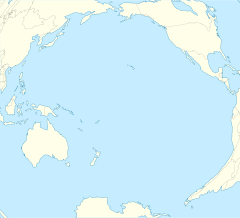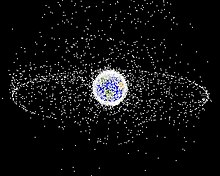
The spacecraft cemetery, known more formally as the South Pacific Ocean(ic) Uninhabited Area, is a region in the southern Pacific Ocean east of New Zealand, where spacecraft that have reached the end of their usefulness are routinely crashed. The area is roughly centered on "Point Nemo", the oceanic pole of inaccessibility, the location farthest from any land.
The defunct space station Mir and six Salyut stations are among those that have been ditched there. Other spacecraft that have been routinely scuttled in the region include various cargo spacecraft to the International Space Station, including Russian Progress cargo craft, the Japan Aerospace Exploration Agency H-II Transfer Vehicle, and the European Space Agency's Automated Transfer Vehicle. A total of more than 263 spacecraft were disposed in this area between 1971 and 2016. The International Space Station is slated to end up in the spacecraft cemetery upon "retirement".
Current considerations of the spacecraft cemetery include the environmental impact it creates on marine life within the South Pacific Ocean Uninhabited Region. This region is beyond legal jurisdiction of any country, and therefore faces less regulation. Currently two treaties outline certain laws that can be applied to the spacecraft cemetery. The Outer Space Treaty produced by the United Nations reflects on damages caused by spacecraft on opposing nations. The United Nations Convention on the Law of the Sea reflects on general marine pollution. In rare cases, marine pollution could be caused by spillage of the highly toxic rocket propellant hydrazine. Other forms of space debris removal are being considered and produced to slow the exponential growth of space debris orbiting Earth due to increased space exploration.
Purpose
Earth's spacecraft cemetery is used as a site for spacecraft that have reached their lifetime limit due to fatigue, lack of propellant or other problems and must be retired. Larger spacecraft too massive to burn up during re-entry into the Earth's atmosphere are controlled to crash / splash down in Earth's spacecraft cemetery, a location in the ocean remote from inhabited regions. The use of this remote location enhances protection of inhabited regions from harm during re-entry and impact. The spacecraft cemetery region contains between 250 and 300 various spacecraft, and has been used by multiple international space exploration organizations, including crafts from China, Russia, and other countries. Currently, the International Space Station is slated to enter the spacecraft cemetery at the end of its lifespan.
Location
The spacecraft cemetery is located inside the South Pacific Ocean Uninhabited Area, a region in the southern Pacific Ocean to the east of the geographic center of the water hemisphere (47°24′42″S 177°22′45″E / 47.411667°S 177.379167°E / -47.411667; 177.379167, near New Zealand's Bounty Islands). The area, roughly centered on "Point Nemo", the oceanic pole of inaccessibility, is furthest away from any land. The nearest islands are over 2,600 kilometres (1,600 mi) away from the center. This location has been chosen for its remoteness and limited shipping traffic so as not to endanger human life with any falling debris.

Incidents
At least 264 spacecraft were disposed in this area between 1971 and 2016. The defunct space station Mir and six Salyut stations are among the nearly 200 pieces of Russian spacecraft debris in this region, making Russia the largest contributor of spacecraft in the cemetery. The remaining pieces of debris in the cemetery belong to the United States, Europe, Japan, and private organizations.
The decommissioning of Tiangong-1, the first Chinese space station, was an unsuccessful targeted re-entry at Point Nemo. During an extended mission phase, control was lost due to a power failure, leading to an uncontrolled landing outside of the spacecraft cemetery.
Laws
Since the South Pacific Ocean Uninhabited Area is beyond the jurisdiction of any country, very few laws restrict the activity of nations within this area. International treaties exist but do not clearly assign responsibility to countries about the liability for damages and pollution caused by re-entering space debris.
Among the pertinent regulations, two general agreements concerning space debris and marine pollution are often expanded upon to govern the spacecraft cemetery.
First, the Outer Space Treaty proposed by the United Nations dictates that each state party is subject to the damages to other state parties caused by part of the registered spacecraft on the Earth, which include the ocean. Therefore, countries are obliged to take action when disposal of registered spacecraft into the ocean causes damages to other parties. However, space debris in the ocean is often left unclaimed.
In the perspective of ocean preservation, the United Nations Convention on the Law of the Sea, also known as Law of the Sea Convention (LOSC), commands that all states have the duty of protecting and preventing marine environment from pollution, even outside the jurisdiction of any state. Nevertheless, this article is only practical when space debris is considered harmful to the marine environment.
Environmental impacts
With 47% of re-entry mass coming from controlled re-entries, chemical spillage poses a risk to the marine environment. Hydrazine, a widely used rocket propellant that is highly toxic to living organisms, may occasionally survive re-entry. Radioactive chemicals present in spacecraft are also a cause for concern in the industry.
There are numerous domestic and international regulatory bodies intended to mitigate potential environmental damage caused by spacecraft pollution. The United Nations Convention on the Law of the Sea is an international treaty overseeing marine pollution and its contributors. This agreement defines pollution using three conditions: 1) the object must have been introduced into the environment by man, 2) the object contains substances, 3) the object must be detrimental to living organisms. Because it is difficult to know how much of a substance remains after it enters the atmosphere, the potential environmental risk of certain spacecraft entering the cemetery may be unknown, leaving much of the treaty up for interpretation. Additionally, the EPA provides protocols on marine pollution declaring the responsibility for pollution mitigation to those who contribute to it and addresses regional cooperation between nations in order to find the least harmful solutions to debris disposal.
Space debris disposal

Space debris is any form of man-made object orbiting the Earth that no longer serves a useful function. Currently more than 27,000 pieces of space debris are orbiting earth at high velocities, threatening the safety of human and robotic missions, as well as causing damage to spacecraft. There are few space debris removal processes, one of which is depositing large spacecraft in the spacecraft cemetery on earth, although, due to exhausted maneuvering fuel reserves, in the past this was rarely done.
The most common way to eliminate space debris, when actually done, is to de-orbit crafts, causing them to burn up during re-entry into the Earth's atmosphere due to high velocities and air compression resulting in a temperature increase of air and the craft's surface. Other common and less controlled processes for space removal include allowing the crafts to decay, collide with other objects, or causing them to explode, resulting in smaller pieces of space debris. As of 2021, new processes for space debris removal are being developed to reduce the unabated proliferation of space debris orbiting earth, such as nets, magnetized collecting arms, and more.
See also
- Aircraft boneyard
- Atmospheric reentry
- Graveyard orbit
- Ship graveyard
- Space archaeology
- Space debris
- Wrecking yard
- Space sustainability
- Splashdown
References
- ^ Smith-Strickland, Kiona (14 May 2015). "This watery graveyard is the resting place for 161 sunken spacecraft". Gizmodo. Retrieved 8 January 2019.
- "Making sure ATV reentry is safe". Orion blog. 30 October 2013. Retrieved 8 January 2019.
- "NZ spacecraft cemetery gets another skip from orbit". 18 January 2007. Archived from the original on 11 October 2008. Retrieved 11 February 2009.
- "MIR Space Station is now reentered – March 23, 2001 – 06:45 UTC". 22 March 2001. Retrieved 1 May 2015.
- "Progress Ship returns to Earth with trash and no longer needed stuff". Progress M-18M mission updates. 26 July 2013. Archived from the original on 1 August 2013. Retrieved 1 July 2013.
- Love, John (21 September 2012). "Lead Increment Scientist's highlights for week of Sept. 10, 2012". NASA. Retrieved 23 September 2012.
- "Image of the Day gallery". NASA. 6 October 2008. Retrieved 5 May 2013.
- "Automated Transfer Vehicle page". European Space Agency. Retrieved 21 June 2011.
- "Mission accomplished for ATV Edoardo Amaldi". Space-Travel.com. 4 October 2012. Retrieved 8 October 2012.
- ^ Stirone, Shannon (13 June 2016). "This is where the International Space Station will go to die". Popular Science magazine. Retrieved 16 June 2016.
- ^ "Point Nemo, Earth's watery graveyard for spacecraft". phys.org. Retrieved 26 October 2021.
- ^ de Lucia, Vito; Iavicoli, Viviana. "From outer space to ocean depths: The 'Spacecraft Cemetery' and the protection of the marine environment in areas beyond national jurisdiction". California Western International Law Journal. 2: 367–369 – via Scholarly Commons.
- ^ "Outer Space Treaty". www.unoosa.org. Retrieved 2 November 2021.
- ^ Convention on the Law of the Sea (PDF) (Report). United Nations. Retrieved 1 November 2021.
- ^ David, Leonard (14 April 2021). "Space junk removal is not going smoothly". Scientific American. Retrieved 3 February 2022.
- ^ "Where do old satellites go when they die?". NASA Space Place (spaceplace.nasa.gov) – NASA Science for Kids. Retrieved 26 October 2021.
- "Mir Re-entry – Updated Analysis". www.zarya.info. Retrieved 28 October 2021.
- "Space Debris Removal, Salvage, and Use: Maritime Lessons". National Space Society. October 2019. Retrieved 3 November 2021.
- ^ 1996 Protocol to the Convention of the Prevention of Marine Pollution by Dumping of Waste and other Matter, 1972 (PDF). Environmental Protection Agency. 1996.
- "What generates all the heat during re-entry when the space shuttle returns to Earth?". Science Guys. www.uu.edu. Jackson, Tennessee: Union University. Retrieved 28 October 2021.
43°34′48″S 142°43′12″W / 43.58000°S 142.72000°W / -43.58000; -142.72000
| Vehicle graveyard | |
|---|---|